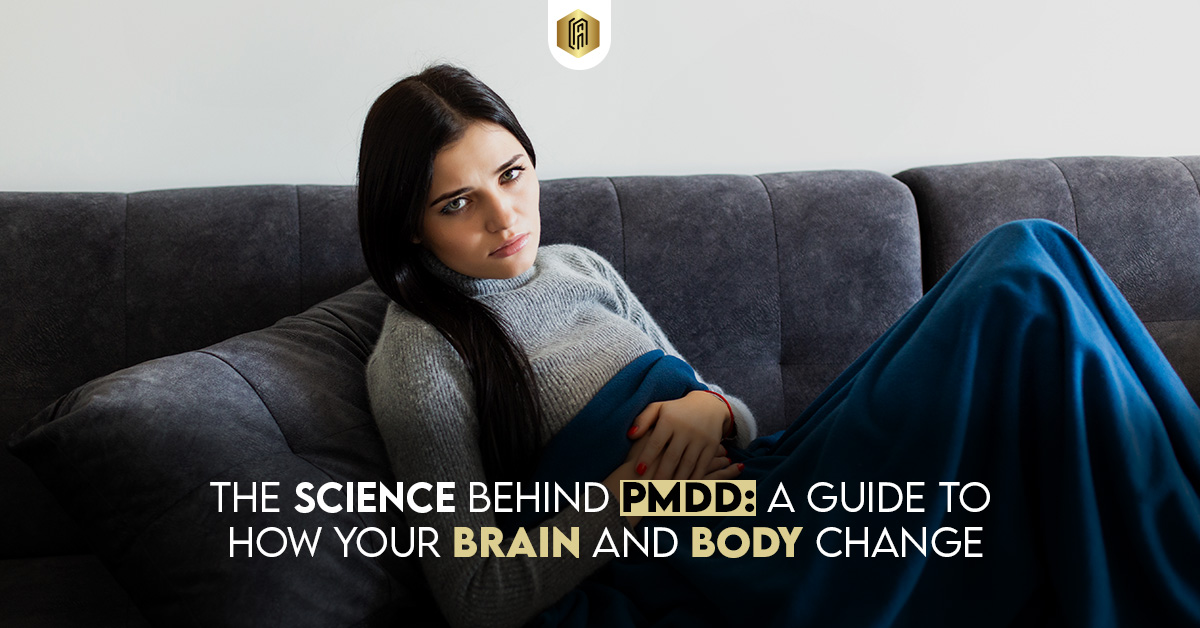Learning about the scientific basis of PMDD
Premenstrual Dysphoric Disorder (PMDD) is a serious and debilitating condition that affects up to 8% of people who have menstrual cycles. PMDD is marked by severe emotional, physical, and cognitive symptoms that occur during the luteal phase, significantly impairing daily functioning. The DSM-5 categorizes PMDD as a depressive disorder, whereas it does not classify PMS in the same way. PMDD is caused by hormonal changes that affect brain chemistry and bodily functions.
This in-depth guide investigates the science behind PMDD and gives a thorough look at the hormones, nerves, and body systems that are involved. We want to make things clearer and give people the information they need to find effective care and management by looking at how PMDD affects the brain and the body.
What Is PMDD? A Full Definition
Premenstrual Dysphoric Disorder (PMDD) is a cyclical, hormone-driven mood disorder characterized by symptoms that appear one to two weeks prior to menstruation and diminish shortly after its commencement. PMDD is different from the more common Premenstrual Syndrome (PMS) because the symptoms are much worse.
What Makes PMS and PMDD Different?
PMS has mild to moderate physical and emotional symptoms, but PMDD has severe symptoms that make it difficult to do things like work, socialize, and take care of yourself. The Diagnostic and Statistical Manual of Mental Disorders, Fifth Edition (DSM-5) says that to be diagnosed with PMDD, you need to have at least five specific symptoms, one of which must be a significant mood-related symptom, confirmed over several menstrual cycles.
Main Types of Symptoms:
Emotionally: Very irritable, depressed, anxious, and mood swings that are very noticeable.
Physical: sore breasts, tiredness, bloating, and pain in the joints or muscles.
Cognitive: Trouble focusing and feeling like you have too much to handle or are out of control.
How common it is and who it affects
PMDD affects about 3–8% of people who have periods, which is millions of people around the world. It usually starts in the teenage years or early twenties, but it can also start later in life. A notable risk factor is a personal or familial history of mood or anxiety disorders, indicating a genetic predisposition. It is important to recognize PMDD as a real medical condition to reduce stigma and get people diagnosed and treated as soon as possible.
The Hormonal Cycle: The Basis of PMDD
A complicated interaction of hormones controls the menstrual cycle. People with PMDD are thought to have severe symptoms because they are more sensitive to normal hormonal changes than to abnormal hormone levels.
A look at the different phases of the menstrual cycle
The menstrual cycle lasts an average of 28 days, but it can last anywhere from 21 to 35 days. It has different parts:
Follicular Phase: The body gets ready for ovulation by raising estrogen levels.
Ovulation: A peak in hormones causes an egg to be released.
Luteal Phase: Levels of progesterone go up. This is the stage when PMDD symptoms start to show up and get worse.
Important hormones and what they do in PMDD
Estrogen: Changes in estrogen levels can affect serotonin, which is a neurotransmitter that controls mood.
Allopregnanolone, a metabolite of progesterone, changes the way GABA receptors work in the brain. This can have the opposite effect on some people, making them more anxious and irritable instead of calming them down.
Cortisol, the stress hormone, can affect reproductive hormones, making PMDD symptoms worse.
To understand the pathophysiology of PMDD, you need to know what hormones are causing it.
Neurological Insights into Brain Changes in PMDD
The emotional and cognitive manifestations of PMDD are directly associated with alterations in brain function and chemistry.
Imbalances in Neurotransmitters
Studies indicate that PMDD is linked to big changes in important neurotransmitters during the luteal phase:
Serotonin: A reduction in serotonin activity is significantly associated with the depressive and anxious manifestations of PMDD. Neuroimaging studies have demonstrated modified serotonin transporter density in individuals with PMDD.
GABA (Gamma-Aminobutyric Acid): This neurotransmitter, which stops other neurotransmitters from working, helps control anxiety. The changing effects of progesterone metabolites on GABA receptors can make you more tense and irritable, and have trouble sleeping.
Dopamine: Changes in dopamine pathways may be responsible for symptoms such as low motivation and mood swings.
Brain Areas That Are Affected
Neuroscientific research has pinpointed significant brain regions that demonstrate modified activity in individuals with PMDD:
Amygdala: This part of the brain is important for processing emotions like fear and anger, and it often reacts more strongly than other parts.
Prefrontal Cortex: Impairments in executive functions, including decision-making and impulse control, may occur.
PMDD may also impact the hippocampal region, which is associated with memory and stress management.
These neurological changes show how PMDD can seriously affect mental health, raising the risk of major depressive episodes and, in extreme cases, thoughts of suicide.
PMDD’s effects on the body: physical signs
PMDD affects more than just the brain; it also causes several physical symptoms throughout the body.
Common Physical Symptoms and Where They Come from
Hormonal effects on different body systems can explain many of the physical symptoms of PMDD:
Bloating and fluid retention: Hormones affect aldosterone, which controls the balance of salt and water in the body.
Pain and cramps: More prostaglandins are made, which make the uterus contract.
Hormonal changes can mess up sleep patterns and circadian rhythms, which can make you feel worn out.
Systemic Effects: Other signs and symptoms can include digestive problems that are like IBS, tension headaches, and acne breakouts.
Long-Term Effects on Health
If not treated, the long-term stress that comes with PMDD can hurt your health in the long run, making you more likely to get heart disease and osteoporosis.
Things that make you more likely to get sick and things that make you sick
The onset of PMDD is multifactorial, encompassing both genetic predispositions and environmental triggers.
Genetic and Biological Factors: The heritability estimates for PMDD range from 50% to 60%. Certain genes associated with hormone receptors (e.g., ESR1) and serotonin pathways are involved.
Environmental and Lifestyle Triggers: Stress can make symptoms worse by using the cortisol pathway. Diet (high in caffeine or sugar), poor sleep, and not getting enough exercise can also make the condition worse.
Diagnosis and Treatment Based on Evidence
The first step to successful management is making the right diagnosis. This usually means keeping track of possible symptoms for at least two cycles in a row to make sure they follow a pattern that makes life harder.
Ways to treat
Lifestyle Changes: The best first steps are to exercise regularly, eat a balanced diet high in calcium, and use stress-reduction techniques like yoga and mindfulness.
Psychotherapy: Cognitive Behavioral Therapy (CBT) has demonstrated efficacy in the management of emotional symptoms.
Medical Interventions:
SSRIs (Selective Serotonin Reuptake Inhibitors): These are often the best medications for PMDD brain changes.
Hormonal Contraceptives: Some birth control pills can stop ovulation and keep hormone levels stable.
Supplements like calcium, vitamin B6, and magnesium may help a little.
Conclusion: Knowledge is Power.
PMDD is a complicated neuroendocrine disorder caused by being sensitive to hormonal changes, which causes significant changes in brain chemistry and how the body works. To get the right care, reduce stigma, and validate PMDE, it’s important to understand the science behind it. People can feel empowered to work with healthcare providers, keep track of their symptoms, and find the treatment strategies that improve their quality of life when they understand how hormones, neurotransmitters, and the body work together.






No comment